Intel Core i7-11700K Review: Blasting Off with Rocket Lake
by Dr. Ian Cutress on March 5, 2021 4:30 PM EST- Posted in
- CPUs
- Intel
- 14nm
- Xe-LP
- Rocket Lake
- Cypress Cove
- i7-11700K
Gaming Tests: Far Cry 5
The fifth title in Ubisoft's Far Cry series lands us right into the unwelcoming arms of an armed militant cult in Montana, one of the many middles-of-nowhere in the United States. With a charismatic and enigmatic adversary, gorgeous landscapes of the northwestern American flavor, and lots of violence, it is classic Far Cry fare. Graphically intensive in an open-world environment, the game mixes in action and exploration with a lot of configurability.
Unfortunately, the game doesn’t like us changing the resolution in the results file when using certain monitors, resorting to 1080p but keeping the quality settings. But resolution scaling does work, so we decided to fix the resolution at 1080p and use a variety of different scaling factors to give the following:
- 720p Low, 1440p Low, 4K Low, 1440p Max.
Far Cry 5 outputs a results file here, but that the file is a HTML file, which showcases a graph of the FPS detected. At no point in the HTML file does it contain the frame times for each frame, but it does show the frames per second, as a value once per second in the graph. The graph in HTML form is a series of (x,y) co-ordinates scaled to the min/max of the graph, rather than the raw (second, FPS) data, and so using regex I carefully tease out the values of the graph, convert them into a (second, FPS) format, and take our values of averages and percentiles that way.
If anyone from Ubisoft wants to chat about building a benchmark platform that would not only help me but also every other member of the tech press build our benchmark testing platform to help our readers decide what is the best hardware to use on your games, please reach out to ian@anandtech.com. Some of the suggestions I want to give you will take less than half a day and it’s easily free advertising to use the benchmark over the next couple of years (or more).
As with the other gaming tests, we run each resolution/setting combination for a minimum of 10 minutes and take the relevant frame data for averages and percentiles.
| AnandTech | Low Resolution Low Quality |
Medium Resolution Low Quality |
High Resolution Low Quality |
Medium Resolution Max Quality |
| Average FPS | 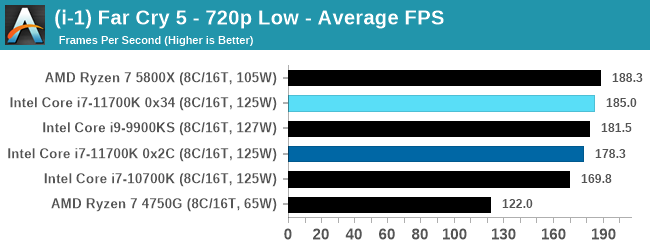 |
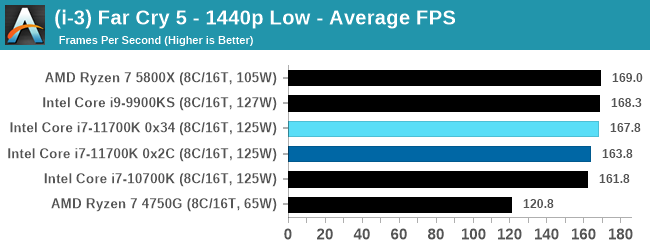 |
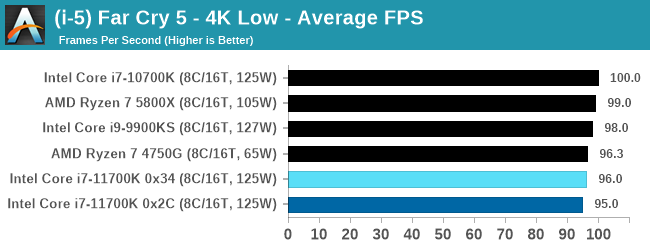 |
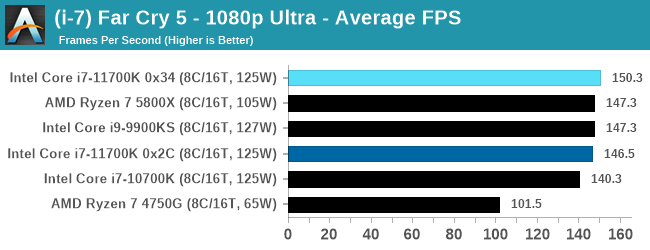 |
| 95th Percentile | 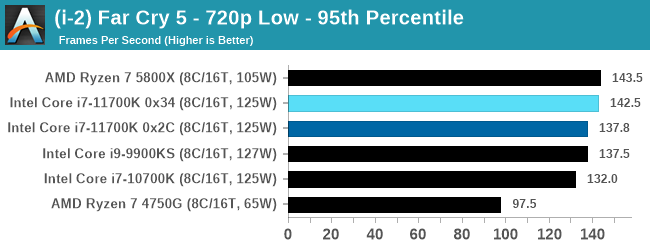 |
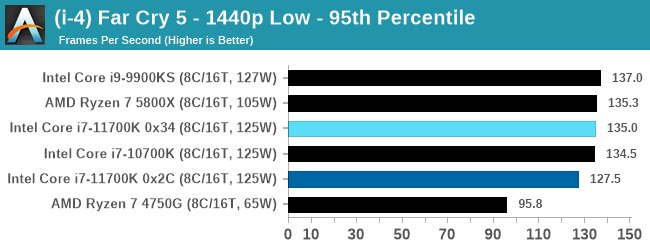 |
 |
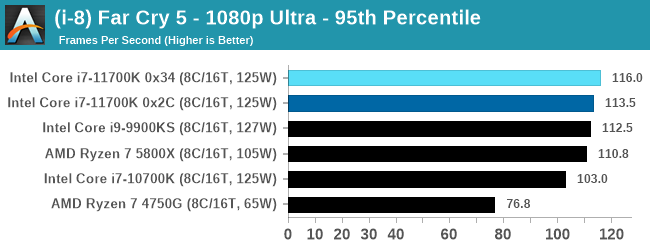 |
All of our benchmark results can also be found in our benchmark engine, Bench.












541 Comments
View All Comments
blppt - Saturday, March 13, 2021 - link
Not really---the Bulldozer design had far more problems than just the inadequate Windows scheduler---while "optimized" linux kernels gave better performance, the true issue with Bulldozer was that you had 8 relatively weak cores versus 4 strong cores from Intel, and at the time, coders were still struggling to optimize for anything over 2 cores.In a sense, the designers of Bulldozer REALLY misread the timeline of highly multithreaded coding taking over the market. Heck, even if it was released now alongside the equivalent Core 2 quads, it would still stink for the majority of users, because no game gets any significant advantage of 4+ physical cores even today---and most games still value high single thread/core performance.
Oxford Guy - Sunday, March 28, 2021 - link
'the true issue with Bulldozer was that you had 8 relatively weak cores versus 4 strong cores from Intel, and at the time, coders were still struggling to optimize for anything over 2 cores. In a sense, the designers of Bulldozer REALLY misread the timeline of highly multithreaded coding taking over the market.'My guess is that AMD designed Bulldozer for the enterprise market and didn't want to invest in an additional design more suited to the consumer desktop space. Instead, its additional design priority was the console scam (Jaguar). While that was a good move for AMD it wasn't beneficial for consumers, as consoles are a parasitic redundancy.
One thing many ignore is that Piledriver supercomputers occupied quite high spots in the world performance lists. Mostly that was due to the majority of their work being done by the GPUs, though. Even the original Bulldozer, in Opteron branding, was used in some.
The cheapness of Piledriver chips was also probably a factor in the adoption of the design for supercomputers. Turn down the voltage/wattage so that you're in the efficient part of the improved 32nm SOI node and rely almost completely on heavily threaded code when not running GPU-specific code... and voila — you have an alternative to the monopoly-priced Intel stuff.
But, on the desktop, Piledriver was a bad joke. That's because of its very poor single-thread performance mainly. Not everything can be multi-threaded and even if it is that can mean a speed regression sometimes. The slowness of the L3, the lack of enough operations caching... the design wasn't even all that optimized for multi-thread performance — especially FPU stuff. The cores were very deeply pipelined, designed to use very high clocks. They were not efficient with avoiding bubbles and such. I read that AMD relied too heavily on automated tools due to cost sensitivity.
My vague understanding of the design is that it was narrow and deep like the Pentium 4. Why AMD tried NetBurst 2.0 is beyond me. Even for the enterprise market it's a bad move because power efficiency is important there, especially with servers (rather than supercomputers which, I think, were more tolerant of high power usage – in terms of acceptable design requirements). Even turning down the clocks/voltage to get the best efficiency from the node doesn't fix the issue of the pipelining inefficiency (although hand-tuned code used for some enterprise/scientific stuff would mask that weakness more than general-purpose consumer-grade apps would).
usiname - Monday, March 8, 2021 - link
Intel know very well that is mistake, but alder lake's big cores are not much better in term of power consumption and 10nm quality wafers so their only choice is to keep the production of max 8 core mainstream. This is bad for them, because even 3 years after AMD show 16 core mainstream they can't and as our very well known Intel they will cheat by introduce their 16 core cpu with 8 fake cores. Even more, when they introduce their "super duper" 12900k with 16 cores they will set price higher than every amd main stream and this is triple win, cheap 8 core cpu for manufacturing, better binned with higher clocks and on price of $800-1000. If you think intel trying to do something new and innovative you are wrong.GeoffreyA - Monday, March 8, 2021 - link
You may well turn out to be right about 16 cores having 8 junk ones, and knowing Intel, that's how they operate, with smoke and mirrors when they can't compete properly.Hifihedgehog - Tuesday, March 9, 2021 - link
The irony here is how Intel used to give ARM smack for having inferior single core performance while they were surpassed in multicore by the likes of Qualcomm. I believe—paraphrasing—what they would say is not all cores are created equal. Well, it looks like Intel is trying to look like they are maintaining parity when they are really just giving us mostly crappy cores that can’t perform well at all.GeoffreyA - Tuesday, March 9, 2021 - link
Also, as others have pointed out before, the nomenclature is just there to obfuscate the whole picture. Not knowing anything much about Alder Lake, I did some searching and saw that it's Golden Cove + Gracemont. Wondering what exactly GC was, I searched a little but couldn't find the answer, so I'll guess it's just Sunny Cove with a new name stuck on.Bagheera - Monday, March 8, 2021 - link
the more I read about Intel's 10nm (check relevant articles on SemiWiki and Semi accurate), the more I feel ADL is designed as a workaround for the power/thermal limitations of their 10nm process, instead of being some sort of revelation for next gen performance.Note how TGL remains Intel's only viable product on 10nm at the moment, with Ice Lake SP now two years late. I think Intel knows their 10nm may never be ready for desktop parts, so ADL is a way to have a desktop product on 10nm except not really (it's more akin to a mobile part).
It will probably do fine for gaming, but highly doubtful it will be a meaningful competition to Zen 4 for the prosumer space.
blppt - Monday, March 8, 2021 - link
Bulldozer/Piledriver were a dumb design because they relied HEAVILY on highly-threaded applications to achieve their performance. Almost none of which existed in the late 2000s when they launched. Single thread/core performance was absolutely pathetic compared to Intel's offerings at the time (Sandy Bridge and on).Zan Lynx - Sunday, March 14, 2021 - link
And yet here we are today with 8 cores in game consoles and AMD's Mantle API being the basis of both DirectX 12 and Vulkan. Multicore was always the future and it was obvious even in 2003.blppt - Monday, March 15, 2021 - link
"And yet here we are today with 8 cores in game consoles and AMD's Mantle API being the basis of both DirectX 12 and Vulkan. Multicore was always the future and it was obvious even in 200"You're missing the point. Even TODAY, few (if any) games gain an advantage of more than 4 physical cores + 4 Virtual. It is still, to this day, far more advantageous for games to have 4 strong physical cores than 8 weak ones. The latter was Bulldozer.
Never mind back in 2011/2012.